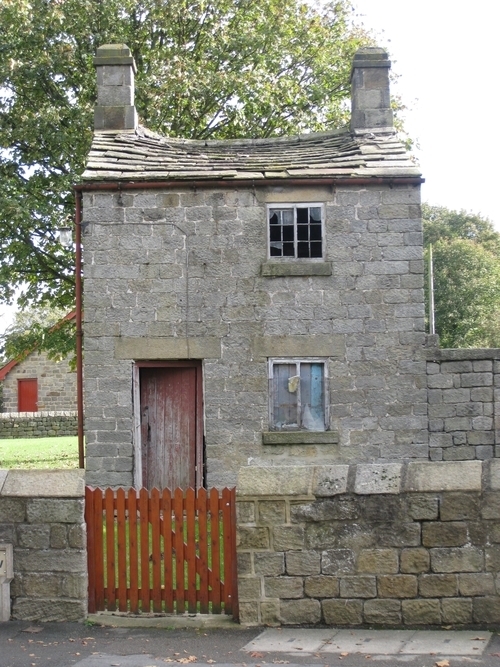Sadler's Cottage
 (click on photo for a larger image in a new window)
(click on photo for a larger image in a new window)
This ancient structure gives a fascinating glimpse into the standard of dwellinghouses in past times. It can be detected,it is believed, on the earliest O.S. Map of 1853 and its appearance suggests an age going back well into the 18th century. The 1853 map (but not the Inclosure Map of 1771) shows a long line or terrace of such buildings of which this was the most southern and with, perhaps, 6 or 7 buildings in the row. It seems to be the sole survivor of a row of artisans' dwellings or workshops (or both!) and its cramped and crude proportions evoke vividly the rigours of life in earlier years.
Its name reflects its occupation by (amongst others) William "Saddler" Haxby who lived and worked in Church Lane. The history of property transactions for Church Lane (
click on Previous owners for that earlier history) reveals the purchase in 1918 of the nearby property of "Ashville" by Mr Haxby who was described in the deed as a saddler. The Haxby name crops up regularly in records of Hampsthwaite but this seems very obviously the same person as the occupant of Saddler's Cottage and we must assume that Ashville was his home and the Cottage his workshop. Annie Pawson (see Book One) said
"In our schooldays the remains of Thackeray's cottage was a joiner's shop. 'Saddler' Haxby was the last to own the property. He was the oldest saddler in Yorkshire and, I think I'm right in saying, the third oldest in the whole of England."
A picture exists of Mr Haxby engaged in bell-ringing (three bells at once!) at the church.

The cottage stands on land belonging to Swallow Cottage and it is assumed that it has been unoccupied since long before Swallow Cottage was built in the 1970s.
William Grainge, in his history "Harrogate and the Forest of Knaresborough" published in 1871, says this of the site . . . . .
"It has been settled beyond the reach of reasonable doubt that Hampsthwaite was the original home of the family of Thackeray, which has been raised to high distinction by the talents of some of its members, but more particularly by the brilliant literary career of William Makepeace Thackeray, whose sudden death cast such a gloom over the world of letters near the close of the year 1863. The old hive from whence the swarms of Thackerays issued yet remains, opposite the vicarage. It consists of three distinct tenements, two storeys in height in front, but only about eight feet in height at the back. The northern gable, with a large projecting chimney, is a piece of excellent masonry, and is probably older than the side walls. The roof is covered with thatch. A day of renovation or rebuilding will come at no distant date, and when it does come we humbly petition the owner to spare the northern gable, and it will long serve as a memorial to mark the dwelling of the great-grandfather of William Makepeace Thackeray, the author of "Vanity Fair".
[Note that the petition failed to prevent the loss of the gable!]
The family from whence he sprang were of yeoman rank, owners of land which they cultivated with their own hands. Walter Thackeray, of Hampsthwaite, who died in 1618, had a son named Robert, which said Robert had a son named Thomas, born in 1628, who by his wife, Margaret, had a family of seven sons and two daughters. The sixth of these sons, named Elias, became rector of Hauxwell, and appears to have been the first of the family to rise to distinction. The fifth son, named Timothy, born in November, 1664, became parish clerk in his native village; he had a family of seven sons and four daughters Thomas, the eldest son, became head master of Harrow School in 1746; D.D. in 1747; and Archdeacon of Surrey in 1753. He was great-grandfather to the celebrated William Makepeace Thackeray, who died suddenly December 24th, 1863, at the early age of 53. He had, however, done enough to live in the memory of posterity.
To return to the Thackerays at home in their quiet nest in the forest village. Elias, the third son of Timothy, succeeded his father as parish clerk, and, on his decease, in July, 1725, Joseph, a younger brother, succeeded to the office, which he probably held until his death, on the 4th January, 1771, when his son, Thomas Thackeray, succeeded, and held the situation thirty-three years, closing his career in January, 1804, and was the last of the family who resided at Hampsthwaite . . . . .
. . . . .A brass plate, inserted in the face of an older altar tomb in the churchyard, bears the following inscription to his memory -
"Here lieth the body of Thomas Thackwray, of this town, son of Joseph Thackwray, clerk of this parish, who departed this life the 21st of January, 1804, aged 56.
Farewell, vain world, I've had enough of thee;
I'm careless, therefore, what thou say'st of me;
Thy smiles I court not, nor thy frowns do fear,
My cares are past, my bones lie quiet here;
What fault thou found'st in me take care to shun,
Look well at home, enough there's to be done."
Return to main map
 (click on photo for a larger image in a new window)
(click on photo for a larger image in a new window)






